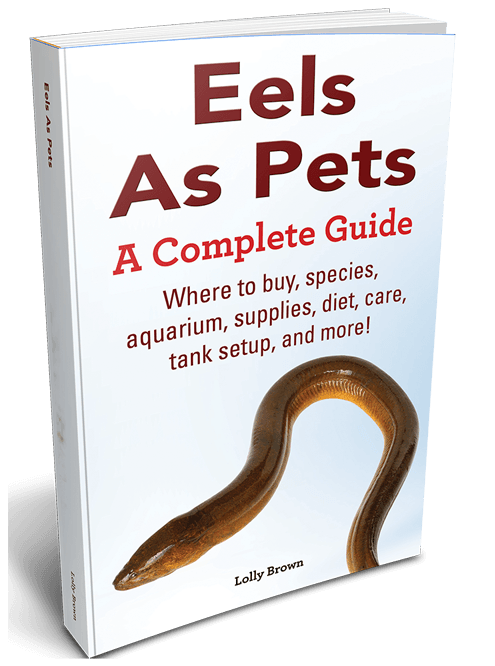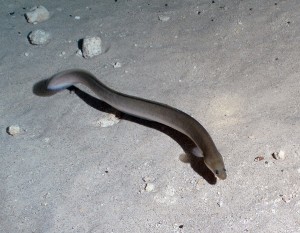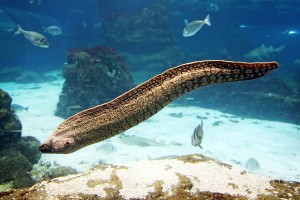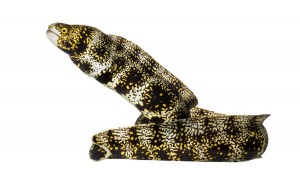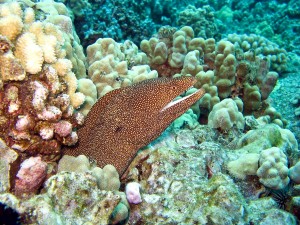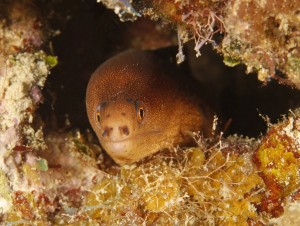Get In Touch
Navigate to chapter
► Chapter 1: Understanding Aquarium “Eels”
► Chapter 2: Saltwater Moray Eels
► Chapter 3: Spiny Eels
► Chapter 4: Eel-Like Fish
► Chapter 5: Miscellaneous Eels
► Chapter 6: Creating Aquatic Environments
► Chapter 7: Creating And Keeping A Moray Tank
► Chapter 8: Health Considerations
► Chapter 9: Frequently Asked Questions
Chapter 1: Understanding Aquarium “Eels”
The long, snake-like fish kept by enthusiasts in both fresh and saltwater aquariums that are commonly referred to as “eels” may be true eels from the order of Anuilliformes, or any one of a number of “eel-like” fishes.
Anuilliformes are elongated fish. They include members of the family Anguillidae like the American Eel and the European Eel, or those found in the family Moringuidae like Worm Eels and Spaghetti Eels.
Spiny Eels, however, are actually “eel-like” fish. They belong to the Mastacembelidae family. Even the well-known Electric Eel (Electrophorus electricus) is actually a Naked-Backed Knifefish (family Gymnotidae.) And Rubber Eels aren’t eels or fish, but amphibiains!
Basically, just because it looks like an eel, doesn’t mean it actually is an eel.
Characteristics of True Eels
All true eels have a laundry list of readily identifiable characteristics including:
- elongated bodies
- a snake-like appearance
- no pelvic fins
- no pectoral fins
- no gill cover openings
- no scales
- continuous dorsal and anal fins
- locomotion via flowing, undulating strokes
- mucous covering for protection against abrasions
Moray eels, in particular, have lateral line pores on their heads. This allows them to hide in crevices and caves with just their heads sticking out while still being able to sense movement in the surrounding water.
In many cases the creatures characterized as “eel-like” fish have none of these special adaptions, but they do have elongated bodies. Because making these distinctions can be very difficult for all but the experts, I am choosing to go with more simplified language.
Using the Term “Eel”
For the purposes of this text, I will discuss “aquarium eels” as a group of eels, fishes, and even amphibians that share the common characteristic of having long, snake-like bodies. These creatures may live in salt or fresh water. Most consume similar diets, and are intelligent fish with a penchant for staging escapes.
If there is one rule of thumb with which to begin your interest in keeping eels it is this: cover your tank, tightly!
The following chapters will provide descriptions of the most popular eels kept by aquarists and look at specialized aspect of their husbandry including the design of tunnels and hiding spaces.
While this book is not intended as a “how to” aquarium book per se, I think it’s important to provide an overview of some of this material, especially for those readers still sitting on the fence about whether or not to take up this pastime.
Be forewarned. Designing and keeping an underwater environment, especially one you have created around a showcase species like a prized eel, can be an all-consuming passion – and an expensive one.
Many of these eels require huge tanks, so large in fact that you may even find yourself reinforcing the floors in your house to accommodate the weight of the water.
For this reason, many eel enthusiasts are forced to dial back their expectations and settle for incorporating smaller “eel like” fish in their tanks. This does not have to be seen as a compromise, however, as many of these creatures are both beautiful and intriguing.
To begin with, however, we will look at some of the largest and most popular eels kept by saltwater aquarists, the moray eels. They are all aggressive carnivores and cannot simply be introduced into any existing saltwater tank without serious considerations of population management.
Buying Aquarium Eels
By and large, the various “eel-like” fish are not difficult to find and can be obtained from any good aquarium store. For larger and rare eels, you may find yourself shopping online.
As an example, Live Aquaria at www.liveaquaria.com offered about half a dozen species at the time of this writing in mid-2014. Of those, four were marked “seasonal” or “out of stock.”
The site offers a “100% arrive alive, stay alive” 14-day guarantee with the option for a refund or account credit. They are located in Rhinelander, Wisconsin. The company cannot ship to Hawaii, APO addresses, post office boxes, Puerto Rico, U.S. territories, or internationally.
Always read the shipping policies of any entity with which
you deal. In most cases, you or someone else will need to be waiting to accept the shipment and care for the eel. Making the best arrangements will likely necessitate a telephone call.
In the UK, look at Tropical Fish by Post at www.tropicalfishbypost.co.uk. They deliver in England, Wales, Scotland, and Ireland. At the time of this writing, the site listed three species, but only the Tire Track Eel was in stock.
Chapter 2: Saltwater Moray Eels
Worldwide there are 15 genera in the family Muraendae to which the moray eels belong. This accounts for a total of 200 species. Of those, about a dozen could be raised in a home aquarium. Only five of those, however, can be safely housed with other fish, and this is still a highly conditional assertion.
- Dragon Moray Eel
- Snowflake Moray Eel
- Zebra Moray Eel
- Whitemouth Moray Eel
- Chainlink MorayEel
The saltwater moray eels are all highly aggressive carnivores. They even look menacing, holding their mouths open not as a means of intimidation, but as a physiological necessity.
A moray eel’s mouth must be open so that muscles in the gill cavity that are attached to the lower jawbone can draw water through the oral cavity and over the gills. The result of this very practical arrangement, however, is an especially fierce appearance augmented by the creature’s pointed fangs that look more than ready to do battle.
Although they are formidable hunters, moray eels are also shy bottom dwellers that require adequate spaces to hide. They possess lateral line pores on their heads that allow them to lie in wait with their heads extended sensing vibrations in the water around them. This ability, combined with their superb sense of smell compensates for limited vision, while the creature’s wedge-shaped head allows it to extract prey from almost any hiding place.
When an eel senses prey entering its perimeter, the eel moves its head from side to side to more accurately find and identify the approaching scent. To confirm their selections, morays eels often tap or bump potential prey with their snouts, using taste and touch receptors in their nose and lips.
In captivity, moray eels are skilled escape artists, and all must be kept in covered tanks. The species most commonly kept by enthusiasts grow to an average maximum length of 3 feet / 0.91 meters, except the Whitemouth, which can reach 4 feet / 1.22 meters.
Moray eels are notoriously difficult to feed in captivity, and are prone to periods of hibernation. Of the five species listed earlier in this chapter, only the Zebra Moray Eel can be housed in a community tank with any great degree of success.
Dragon Moray Eel
Other common names: Leopard Moray Eel, Japanese Dragon Moray Eel
The Dragon Moray Eel (Enchelycore pardalis) is especially distinctive for the horns (exterior nostrils) that grow directly over the eyes creating the dragon-like appearance from which the species draws its name.
The creature’s native range extends from Hawaii to southern Japan and south to the Indo-Pacific region. A predatory bottom dweller, it requires plenty of hiding places.
Because Dragon Eels do not tolerate deep, cold water, they rarely swim below 164 feet / 50 meters in the ocean. They are commonly found on living reefs, in caves, under overhangs, amid sunken wreckage, and in intertidal zones along rocky coastlines.
Physically stunning, Dragon Eels experience changes in both their colors and markings as they mature. Adults are primarily bright yellow with unusual patterns of lines and spots on the body in hues of orange/red, black, and white. The dorsal fin is covered in either contiguous blotches or vertical bars.
When fully mature, captive specimens generally fall in a range of 30-33 inches / 0.76-0.83 meters, while their wild counterparts are often as long as 3 feet / 0.91 meters.
Clearly, based on size alone, a Dragon Eel requires a large tank. Experts agree that while a 100-gallon / 378.5-liter tank is an acceptable minimum, 125 gallons / 473 liters is preferable.
Specific water quality parameters for successful husbandry include:
- pH: 8.1-8.4
- Specific Gravity: 1.020-1.025
- Temperature: 72-78 F (22-26 C)
Most captive deaths in eel species are a direct result of either poor water quality or stress. When first introduced to a tank, a Dragon Moray will typically go into complete hiding. Leave the creature alone! This solitary acclimatization is crucial.
Because this is a highly aggressive species with large teeth and a bottom jaw that cannot close due to its curvature, the Dragon Eel presents challenges when housed with other types of marine life including other eel species.
For this reason, it’s best to keep only one Dragon Eel at a time and only in a tank specifically designed for other aggressive species including Groupers, Triggers, Snappers, Puffers, Lionfishes, and Hawks.
(Please note that some Dragon Eel enthusiasts think this species is a better candidate for a quiet reef tank since the amount of waste produced by other fish can be a problem given the species’ need for superior water quality. Top-notch filtration and protein skimming are a must with Dragon Morays.)
As a carnivorous hunter, the Dragon Eel prefers to hunt and dine on live foods; therefore it can be difficult to feed in captivity. Your best food choices are live squid, shrimp, crab, and small fish offered on a feeding stick.
Even in the best-case scenario, however, individuals will only eat a couple of times a week. It is not unusual (nor a cause for alarm) for a newly introduced eel to go several weeks without feeding at all. The species also goes through periods of “hibernation,” during which it hides constantly and refuses all food.
Dragon Moray Eels are expensive. Depending on the size at purchase, expect to pay $1000+ / £592+.
Snowflake Moray Eel
Other Common Names: Snowflake Moray, Clouded Moray, Nebulous or Starry Moray.
The Snowflake Moray Eel (Echidna nebulosa) has a white or cream body with branching black blotches that contain one or two yellow spots. There are also yellow markings on the head and the eyes are yellow.
The Snowflake’s native range extends southward from Hawaii to Australia and west through the Indo-Pacific and into the East Indies as well as across the Indian Ocean and along the coast of Africa.
The creatures are commonly found in reef lagoons and on reef slopes. They are not a deep water fish, rarely going below 98.4 feet / 30 meters.
They also frequent tidal zones and may be seen slithering out of the water at low tide to feed on shore crabs and other small crustaceans, including mantis shrimp and small bony fish as well as small cephalopods.
Snowflakes are considered to be one of the most beautiful of the morays, a fact that contributes to their popularity with aquarists. They can reach 3 feet / 0.91 meters in
length, but typically stay within 12-24 inches / 0.30-0.60 meters in captivity and therefore can be housed in a 75-gallon / 283.9-liter tank.
Although Snowflake Eels are considered less aggressive than other saltwater morays, they can become combative at feeding time, even going so far as to take a bite out of a passing fish. This is why the use of a feeding stick is recommended.
Using this rigid tube, the food item can be placed within inches of the eel, thus controlling the extent of its potential excited aggression. In fact, Snowflake eels that are trained to take food from a stick tend to wait for their meal to be offered to them.
Snowflake eels have blunt teeth, which they use to crush their prey. For this reason they are sometimes referred to as a “pebble-toothed moray.” In captivity, they especially like crustaceans, but will also eat fish. Over time, and with patience, they can be taught to accept a wide variety of fresh and frozen foods including: clams, crabs, shrimp, scallops, and various fish meats.
Typically Snowflake eels will eat several times a week, which helps them to ignore the potential of other tank inhabitants becoming tasty snacks. Like other moray eels, the Snowflake will often go into a period of hibernation during which it refuses to eat for several weeks.
This species should only be kept with other aggressive fish, preferably those that are larger than the eel itself, which will discourage any predation. They are not appropriate for a reef tank. The necessary water parameters are:
- pH: 8.1-8.4
- Specific Gravity: 1.020-1.025
- Temperature: 74-82ºF (23.3-27.7C)
Snowflake Eels are superb escape artists and due to their slender build, can get through gaps that would stop other eels. Tight tank security is required to keep this species.
In comparison to other eels, the Snowflake Moray is relatively inexpensive, selling for $30-$60 depending on size (£17.82-£35.64)
Zebra Moray Eel
The Zebra Moray Eel (Gymnomuraena zebra) is one of the more docile of the morays. Since it is not normally aggressive with smaller fish, this reclusive bottom dweller can be kept in a community fish tank, but will need at least 4 inches / 10.16 cm of substrate.
A Zebra Eel will stay hidden most of the day with nothing more than its head sticking out, but over time will become comfortable enough to emerge and look for food even when the tank lights are on.
A native of the warm waters of the Pacific and Indian Oceans and the Red Sea, Zebra Morays inhabit coral and rock reefs. The name “zebra” is well chosen for this striking eel with its dark brown body circled in thin white bands. Captive adults can reach a maximum length of 3 feet / 0.91 meters, but will do well in a 75-gallon / 283.9-liter tank or larger.
The Zebra Eel uses its pebble-like, blunt teeth to crush crustaceans, which are its favorite meal, but many small items are swallowed whole. When first introduced to a tank, Zebras frequently refuse to eat, but can be enticed with live feeder crabs.
In a home aquarium, this will sound like a holiday nutcracker when the eel holds down the crab with the coils of its body and snaps off the claws.
Juvenile Zebra Morays adapt more readily to aquarium life, and can be acclimated to frozen items including crab, clam, scallop, shrimp, fish, and squid meat. Since Zebras must be fed several times a week, it’s a good idea to get them accustomed early in life to a variety of acceptable foods.
Be aware, however, that a Zebra Eel, like others of its kind, can enter a hibernation period lasting several weeks during which time it will eat nothing. Individuals may become aggressive at meal times necessitating the use of a feeding stick, and their preference is to hunt or be fed behind reef structures rather than out in the open.
Specific water parameters for Zebra Moray Eels include:
- pH: 8.1-8.4
- Specific Gravity: 1.020-1.025
- Temperature: 72-78 F (22.2-25.5 C)
Due to their shy and reclusive nature, they should be provided with ample rock structures in which to hide. They are NOT, however, considered safe for reef tanks since they will happily snack on ornamental crustaceans and shelled invertebrates.
As Zebra Morays age, they become much thicker in the body and very muscular, which contributes to their more or less clumsy behavior. Any structures you place in the tank have to be large and strong to withstand a Zebra blundering about, especially at feeding time.
Zebra Moray Eels are moderately priced in a range of $120-$300 (£71.28-£178.22) depending on size at purchase.
Whitemouth Moray Eel
Other Common Names: Guinea Moray Eel, Guineafowl Moray, Painted Moray, Puhi’onio, Spotted Eel, Spotted Moray, Turkey Moray
The Whitemouth Moray Eel (Gymnothorax meleagris) is indigenous to the Indo-Pacific. Its preference for shallow water is so pronounced, it can often be found at depths of just 3 feet / 0.91 meters in lagoons, intertidal zones, rock-strewn flats, and seaward reefs.
Even in captivity, adults can grow to a maximum length of 4 feet / 1.21 meters. For this reason the recommended minimum tank size for the species is 200 gallons / 757 liters.
The brown to yellow-brown body is liberally covered in white spots edged in a dark tone. The inside of the mouth and tip of the tail are white, while the gill openings are surrounded by black blotches. The upper jaw holds two enlarged canine teeth.
The species can be kept with other morays, but only in very large tanks. Whitemouth Eels will, however, eat ornamental shrimp and smaller fish.
Typically the species should be fed twice a week on live, fresh, or frozen fish and crustacean meat. It is not unusual for these eels to “hibernate” for as long as two weeks at a time and to eat nothing during that period.
Provide a Whitemouth Eel with plenty of hiding places, but do not try to keep them in a reef tank. Specific water parameters should be:
- pH: above 8.0
- Specific Gravity: 1.022 – 1.025
- Temperature: 72-82 F (22.2-27.7 C)
Whitemouth Morays are very prone to jumping right out of the tank, so extra vigilance is required when opening and closing the lid.
Depending on the size at purchase, Whitemouth Morays are generally priced from $150 to $175 (£89.67-£104.61).
Chainlink Moray Eel
Other Common Names: Chain Moray
The Chainlink Moray Eel, (Echidna catenata) is indigenous to the warm waters off Brazil where it lives in rock and coral reefs. As juveniles, these eels are banded in green with alternating yellow stripes. Pattern and coloration varies widely by individual. As the eels age, their color and markings tend to become lighter and run together.
They are reclusive, nocturnal predators feeding primarily on crabs that they pursue with such avidity they will even leave the water and come onto shore to capture them. Chainlink Moray Eels adapt surprisingly well to aquarium life so long as they have adequate hiding places and are allowed enough time to acclimate themselves.
Since a Chainlink Moray can reach a maximum size of 2 feet 6 inches, a tank 125 gallons / 473.18 liters or larger is required.
In the beginning, a diet of live fiddler or blue crabs will be required, but over time this species will accept prepared foods and can learn to take chunks offered on a feeding stick. Adults need 2-3 meals per week.
Suggested water parameters include:
- pH1-8.4
- sg 1.020-1.025
- temperature72-78 F / 22.2-25.5 C
The typical size at sale for a Chainlink Eel is 6-8 inches / 15.24-20.32 cm at a price of $50 / £29.79.
Other Moray Species
Although these five moray species are the ones most typically seen in the hobby today, there are other species that crop up from time to time, including the Dwarf or Golden Dwarf Moray, which grows to a maximum length of only 10 inches / 25.4 cm, making it a desirable addition for enthusiasts of “nano” reef tanks (approximately 15 gallons / 56.78 liters.)
Dwarf or Golden Dwarf Moray
The Golden Dwarf Moray (Gymnothorax melatremus) is indigenous to the Indo-Pacific and varies in coloration from yellow to dark yellow or orange. Like all morays, they enjoy rocky hiding places and are skilled at escaping from tanks.
Although tiny in comparison to the massive morays described earlier in the chapter, this creature is still a carnivore, preferring silversides, clams, and pieces of fish, but generally agreeable to frozen foods.
The Golden Dwarf Moray is not overtly an aggressive and will cohabitate peacefully even with small fish. It does best in stable, well-maintained water in a temperature range of 72-82 F / 22-28 C.
Although desirable for its size and agreeable nature, this is an extremely rare eel. When a company does acquire a few specimens for sale, they disappear quickly.
The Golden Dwarf Moray is difficult to locate and may cost as much as $400 / £239.30.
Golden Moray Eel
The Golden Moray Eel (Gymnothorax miliaris), sometimes referred to as the Goldentail Moray, is another species that occasionally shows up in the hobby. Technically it is the same species as the Fire Coral Eel, but in the rare yellow coloration.
Indigenous to reefs off South America, it is also popular for its relatively small adult size of just 2 feet 3 inches / 0.69 meters when fully grown.
There are several color variations, ranging from speckled brown and gold to bright yellow with the brighter shades being the most rare and most desirable.
This moray dines on crustaceans and occasionally small fish, so care should be taken when picking potential tank mates. Smaller species will likely not fare well in the company of a Golden Moray Eel.
Only highly experienced aquarists should attempt to raise this species since the Golden Moray is capable of inflicting severe bites. A minimum 125 gallon / 473 liter tank is recommended with the following water paramters:
- pH1-8.4
- sg 1.020-1.025
- temperature72-78 F / 22.2-25.5 C
At purchase, Golden Moray Eels are 4-18 inches / 10.16-45.72 cm and cost $700-$800 / £420-£480.
Fire Coral Eel
As mentioned above, the Fire Coral Eel is the same species as the Golden Moray Eel, but it is black with gold spots covering the body. Otherwise, all of the care parameters are identical to those provided for the Golden Moray Eel, but this is a much more common variant of the species, selling in a range of $190-$230 / £114-£138.
Tessalata Moray Eel
Other Common Names: Laced Moray, Leopard Moray, Tesselate Moray, or Honeycomb Moray
The Tessalata Moray Eel (Gymnothorax favagineus) is a handsome specimen, displaying a brown leopard pattern over a yellow white background.
The species is indigenous to the Indo-Pacific, East Africa to Papua New Guinea, north to the tip of Japan, and south to Australia. They live at depths of as much as 148 feet / 45 meters.
Typically they prefer crevices in reefs, and need aquascaping with sufficient caves and niches to completely shelter their bodies.
It should be noted that Tessalata Moray Eels produce an especially high bio-load, necessitating the need for strong mechanical and biological filtration.
This species can be kept in an aquarium, but grows to a maximum size of 5 feet 8 inches / 1.8 meters, thus requiring 180 gallons / 681.37 liters at minimum.
Most experts agree that the tank should have a width of at least 2 feet (0.6 meters) front to back and a length of six feet (1.83 meters).
Tessalata Morays are highly aggressive and should only be kept with other large aggressive species. Their level of aggression increases markedly at feeding time. Appropriate meaty foods include raw shrimp, squid, krill, clam, and mussel.
They will accept food offered on a feeding stick and typically are not reticent about feeding when first introduced to a tank problem, a behavior common among many other morays.
Tessalata Morays are generally 6-18 inches / 15.24-45.72 cm at purchase and sell for $150 to $200 / £90-£120.
Miscellaneous Morays
Although less popular or more difficult to obtain, you may also see the following species from time to time in the hobby:
- Barred Moray (Echidna polyzana), an eel indigenous to the Red Sea and eastern Africa east to Hawaii. Maximum adult size 30 inches / 0.76 meters. Requires a 75-gallon tank / 284-liter. Crustaceans are the primary diet for this pale to charcoal gray eel banded in bars of white or cream. They are active tank inhabitants and must be placed with fish that will not harass them. These eels will not thrive with fast moving or “nippy” fish like angels, tangs, triggers, or wrasses.
- Abbott’s Moray(Gymnothorax eurosus) reaches a maxium adult size of 24-30 inches / 0.60-0.76 meters and can be kept in a 75-gallon / 284-liter tank. They are strictly nocturnal and are indiscriminate carnivores. Colorations range from purple to light brown with golden to yellow-brown freckling. Without lots of rockwork and retreats built into the aquascaping of a tank, this species will not feel safe and may starve to death. Should be kept alone or with docile species only.
- The Blackspotted Moray(Gymnothorax favagineus) is a mammoth among the morays, reaching a gigantic size of 10 feet / 3.04 meters, which demands 200 gallons / 757 liters at minimum. It is a top reef predator, and a truly beautiful specimen with a white to yellow base color covered in irregular brown to black spots. It is sometimes referred to as the Honeycomb Moray. This species has a double row of razor sharp teeth and is capable of inflicting a painful bite. Definitely a species for an experienced aquarist only.
- The Fimbriated Moray(Gymnothorax fimbriatus) is a native of the Indo-Pacific that seldom grows larger than 30-32 inches / 0.76-0.81 meters. Requires a 75-gallon tank / 284-liter. It is a reef eel that also favors tidal flats, overhangs, seaward ledges, mangrove tangles, grassy sandbars, and shipwrecks. The base color is light tan to a yellow-green and is accented by random dark spots. This species has a tendency to be finicky in captivity and should not be exposed to more than 8-10 hours of light per day.
- The Yellow-Edged Moray(Gymnothorax flavimarginatus) is another massive moray, reaching 6 feet / 1.8 meters in length in captivity, and 6.5 feet / 1.9 meters in the wild. It is widespread throughout the Indo-Pacific region and is a resident of shallow to deep water, from tidal pools to depths of 525 feet / 160 meters. They are powerful and opportunistic predators. The base color is yellowish overlaid with a dense mass of brown to black spots and speckles. Red eyes sit above the elongated snout flanked by bulging jaw muscles. The species requires at least a 500-gallon aquarium, and should only be attempted by extremely experienced and perhaps professional aquarists. A Yellow-Edged Moray will basically attack anything that moved.
Want to read the entire thing?
